Making perfect queso fresco cheese is easier than you think. You don't need special equipment or hard to obtain ingredients. You need milk, vinegar, and salt. That's it? Yup, that's it! Well, you will need cheesecloth, but that's not really an ingredient. You will also need a good digital thermometer for accurate reading. So, let's make some queso fresco!
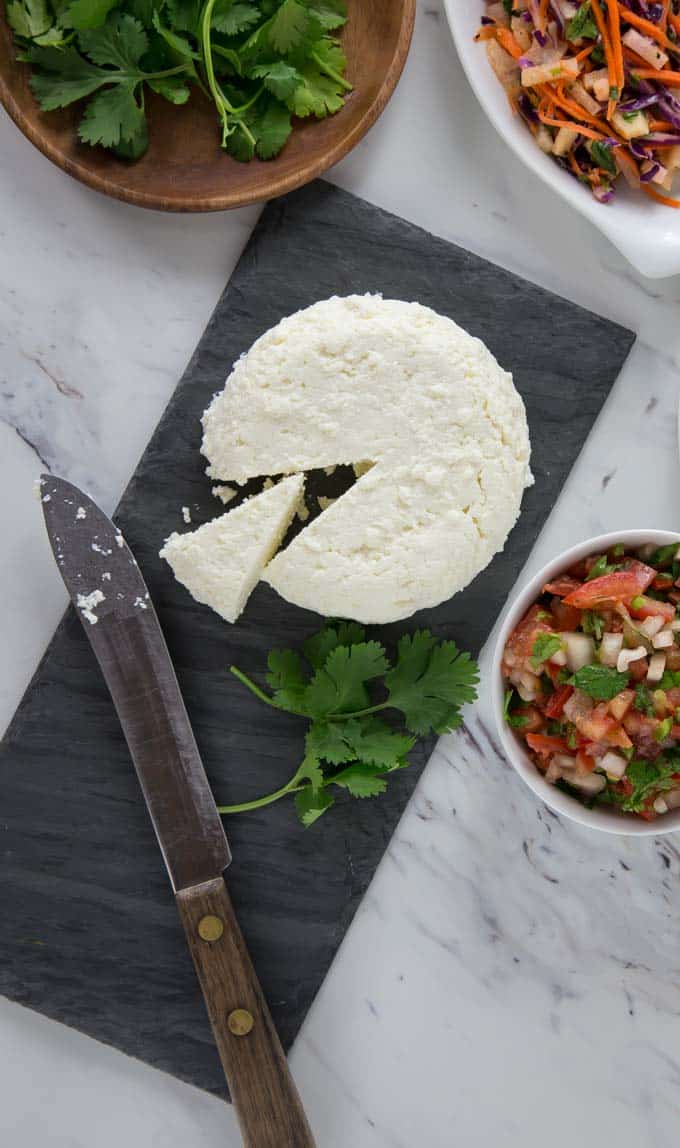
Jump to:
What is queso fresco?
Queso fresco is a one of many popular Mexican cheeses made from whole milk. It is considered a fresh cheese since it is not and aged cheese and is ready to eat right after you make it. It is soft, moist and crumbly so it works great as a topping for tacos, nachos or sprinkling on salads and soups. It is similar to other types of white cheese like farmer's cheese or paneer from India.
Before I go on, I need to clarify something: queso fresco is curdled with acid, like lemon juice, lime juice or vinegar. Queso fresco will have a slight tangy flavor. Queso blanco, a similar cheese is curdled with rennet, an animal enzyme that you can usually find in the baking aisle of the grocery store. There are also some vegetarian rennet products, but I don't have any experience with them.
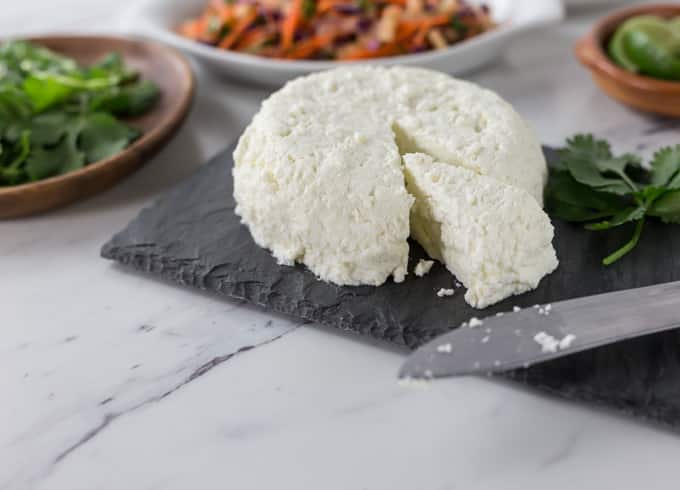
Cheesemaking is another hobby
I've tried making ricotta, and goat cheese. The process for making queso fresco is similar, and again, most of the time you will not need special ingredients. Mozzarella cheese and burrata are next on my list. Being Latin American, I really had to try my hand at making queso fresco because you can use it in so many different ways. I like to spread it on baguette and top it with a bit of fig jam. Do you like nachos? Queso fresco is a mild cheese and perfect over tortilla chips to balance a spicy salsa like sour cream does.
The origins of cheese-making go back to approximately the 5th millennium BC, and is attributed to pastoral societies. Terracotta vats with what appear to be draining holes have been found at excavation sites. There is also evidence of cheese-making from drawings found in Egyptians tombs. By the time of the Roman Empire cheese-making was already an established art.
Visual steps to make homemade queso fresco:

- Step 1: Place the half gallon of whole milk or raw milk in a large pot on medium heat. While the milk is heating place a colander over a large bowl and line colander with cheese cloth.
- Step 2: Heat the milk to 170° F, remove from the heat and then add the vinegars to the milk and stir it a couple times. Let it sit for 30-45 minutes.
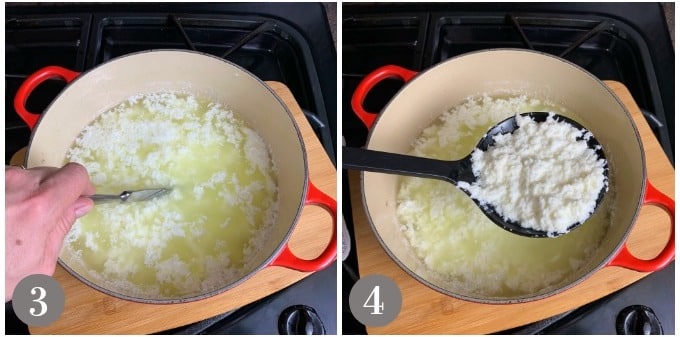
- Step 3: Cut the curds with a knife.
- Step 4: Using a slotted spoon remove the curds and add to the cheesecloth in the colander. Stir the salt into the curds once all the curds are in the cloth.
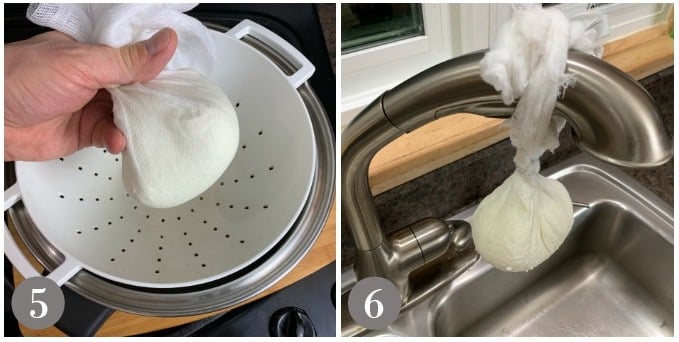
- Step 5: After all the curds are in the colander gather the edges of the cheesecloth and form a ball and tie it off with butcher's twine or some twist ties.
- Step 6: Hang the cheesecloth over your sink faucet and allow to drip for 30 minutes. After 30 minutes you can form a ball from the curds, remove from the cloth. Press the curds into a flat disc and set it in the colander and allow to drip for another 30 minutes. Once it stops dripping you can place in a sealed container in the refrigerator until ready to use. Enjoy your fresh soft cheese!
Ways to use queso fresco:
- Tostadas: Add some refried beans to a crispy tortilla along with tomato, onion, pork carnitas, avocado and top with your favorite salsa or pico de gallo and queso fresco.
- Taco Tuesday: Add your favorite taco fillings and add some queso fresco too! It is hard to beat homemade queso in a taco. Make some fresh queso for cinco de Mayo
- Enchiladas: Bake your enchiladas and add the queso fresco before serving. Queso fresco is a crumbly cheese and can work as a topping for just about any Mexican cuisine.
- Arepas - Similar to tortillas, these are corn griddle cakes from Venezuela that are stuffed with stewed meat, herbs, cheese, plantains..really the choice is yours!
- Jibarito - A Puerto-Rican inspired dish that actually hails from Chicago. Two planks of fried plantain make the "bread" for this sandwich.
- Elote - A Mexican grilled corn on the cob topped with cheese, spicy mayo, and herbs. You can also use cotija cheese but you can swap since you have a fresh queso fresco recipe.
- Soups: You can add some as a topping to your favorite Mexican restaurant style soups like chicken tortilla soup.
Ingredients notes and equipment
- Whole cow's milk or raw cow's milk: This full fat milk will give the best results. If you have access to goat milk you can try a similar recipe for goat cheese.
- Vinegar: This recipe calls for white distilled vinegar and apple cider vinegar. This is the key ingredient for acid-set cheese or acid coagulated cheeses. Other types of acid-set cheese are cottage cheese, quark or cream cheese. You can read more about these types of cheeses at the University of Guelph.
- Salt: Use cheese salt or a non-iodized salt like Kosher salt.
- Dutch oven or pasta pot: Heat the milk in a large pot and I prefer one with a heavy bottom to give very even heat distribution.
- Digital thermometer: You want to be sure to get the milk to exactly 170°F while stirring.
- Cheesecloth and colander: Line your colander with the cheesecloth to allow the whey to drain off while gather your curds. A slotted spoon work well to scoop them up.
Frequently asked questions
I typically recommend eating the queso fresco within a week, making sure to keep it refrigerated and properly sealed in an airtight container.
Yes, you can gently rinse the curds in the cheesecloth and it will remove some of the tangy flavor of the acid used to coagulate the milk. I like a slightly salty and tangy cheese.
You can add a small amount of heavy cream to the cheese to get the desired creaminess. You only need a small amount so add a teaspoon at time and mash it into the cheese.
Queso fresco is not a melting cheese. It will get soft but stay a bit chunky. Many Mexican kitchens make queso dip from white American or Monterey Jack cheese, milk and some chilis.
Finally, please give this a try. Without a doubt you will find that making queso fresco is super easy and very rewarding. And, don't forget to share with your friends.

How to Make Perfect Queso Fresco
Ingredients
- ½ gal whole milk
- ⅔ cup vinegar white, distilled
- 1 Tbsp apple cider vinegar
- 1 ½ tsp Kosher salt
Instructions
- Place a cheese cloth lined colander over a large bowl of pasta pot.
- On medium heat bring milk to 170°F, stirring constantly to avoid uneven heating.
- When the milk reaches the desired temperature, remove from heat and add vinegar types. Stir a couple of times, then allow it to sit untouched on the stove top for about 30-45 minutes.
- Using a knife start breaking up the curds gently then start transferring to a colander using a slotted spoon.
- Allow the curds to sit untouched for about 30 minutes so they can drain properly. Add salt and stir lightly.
- Next, gather the edges of the cheesecloth and tie with kitchen twine or a twist tie. Hang from your sink faucet, and allow it to drip for about 30 minutes.
- Remove from the cloth and using your hands gently mold the cheese into a flat disc, about 1" tall.
- Return to the colander and let it sit this way for about 30 minutes.
- Transfer cheese to a bowl, and place in the refrigerator until ready to use.
Notes
- Whole cow's milk or raw cow's milk: This full fat milk will give the best results. If you have access to goat milk you can try a similar recipe for goat cheese.
- Vinegar: This recipe calls for white distilled vinegar and apple cider vinegar. This is the key ingredient for acid-set cheese or acid coagulated cheeses. Other types of acid-set cheese are cottage cheese, quark or cream cheese.
- Salt: Use cheese salt or a non-iodized salt like Kosher salt.
- Dutch oven or pasta pot: Heat the milk in a large pot and I prefer one with a heavy bottom to give very even heat distribution.
- Digital thermometer: You want to be sure to get the milk to exactly 170°F while stirring.
- Cheesecloth and colander: Line your colander with the cheesecloth to allow the whey to drain off while gather your curds. A slotted spoon work well to scoop them up.


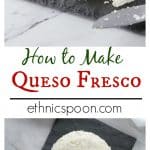

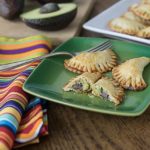
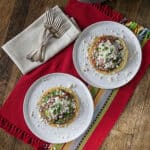
KR
Wonderful! I just published in my blog post about Estonian home- made quark- cheese 🙂 So similar and so different 🙂 World is small:)
https://estoniancuisine.com/2017/06/04/soir-estonian-quark-cheese-with-caraway-seeds/
Analida
Hi KR! Thanks for commenting. I will check out your blog for your quark cheese. Have a wonderful day.
Jim
Will be making my first try at making a cheese today. Will be using this recipe
Let you know tomorrow how it turns out
Thanks
Mamalia
Quesco Fresco is great for usage in different areas. I guess a combination with nachos should be a consideration for me.
Analida
Hi Mamalia! I think queso fresco is good with anything. 🙂
Jacque Hastert
This has been the best thing I have read all day. I would like the bowl clean at restaurants if it wasn't frowned upon.
Krista Price
I've never made cheese before, but now I feel like a queso fresco expert! It's easier than I thought! Thanks for sharing!
Aleta
Oh Analida, this recipe is the answer to my dreams come true! I cannot believe how easy it is to make Queso fresco. I LOVE the stuff but in my small home town it is surprisingly (any annoyingly) hard to come by! There are so many delicious dishes I want to make with it and now when I need to, I can make my own with your recipe! Thank you so much for sharing!
Analida
Let me know how you like it!
Raditz
business opportunity if you ask me !!! Lol
Elaine Benoit
This does look perfect Analida!! My mom used to make cheese when I was growing up, but I've never tried it myself! I can't wait to try your recipe!
Eva
It's been such a long time sine I made this! I remember making a cheese like this in primary school, using lemon juice to curd the milk. It was one of the first foods I cooked, now that I think about it. Made me want to try again, I was so proud with it!
Pam Greer
I've been wanting to try cheesemaking. You have convinced me that I should! I'll start with this recipe!
Dana
I have always wanted to make this but had no idea how! It looks wonderful and I think I can do it!
Kiki Johnson
This queso looks absolutely perfect - the texture is just like the storebought one we get in Mexico! I would love to try and make this at home! Such a fun weekend project
Anne Murphy
Oh, cool! I've made similar types of cheese, but didn't know queso fresco was in that category! It really is easy, and the flavor is so good.
Sri Mallya
Thank you so much for sharing. I love Queso Fresco almonst in anything but never knew it was easy to make. I will soon try this out.
Analida
It is very easy and it is a blank canvas! Add your own herbs to the cheese mix!
Kathryn
I love queso fresco but have actually never made it. Pinning this for later!
Loreto Nardelli
Hi Analida, we have just started making ricotta and my parents would make a salt cheese. I always like to watch the process but now have an appreciation for cheese making. This is very similar to making ricotta. I love the simplicity of it and also the use of herbs and other flavors intrigues me immensely. Thanks for the inspiration and good luck with the mozzarella and burrata. Definitely want to see those recipes, yum!
Happy Holidays!
Loreto@sugarlovespices..
Leslie Haasch
I've never tried to make cheese before, but you make it sound totally doable. I just love cheese so much, I can't bear the idea of potentially screwing it up, haha!
Tammy
I never thought about making my own cheese but this is awesome! What an easy method and one I'm definitely inspired to try now 😀
Chtis
I LOVE to cook and I'm quite good at it but the thought to make my own cheeses has never crossed my mind. Thank you very much , after reading your recipe I completely inspired and cant wait to make some cheese !!! M
Analida
Thanks Chris! Let me know how it turns out.
Jamie
Analida, I was wondering what two types of vinegar you reference above. Obviously the one is cider but what is the other? I will make this recipe for my son's bachelor party this weekend. He wants a taco bar and I want to make queso fresco. So that's a great excuse to make it.
Analida
Hi Jamie, Thanks for reaching out to me! The other vinegar is white distilled and I have updated the recipe too. Let me know how you like it!
Harini
This looks so doable and good. Would love to give this cheese a try!
Amy
Thanks for such wonderful instructions!
Nina
Good morning Analida:
Thank you so much for this super recipe!!!!!
👩🏼🍳😋 The Queso Fresco 🧀🧀came out perfectly. The flavor is outstanding. 😘So much better than packaged/store bought. This is our new go to cheese, no more store bought stuff. Like knowing exact ingredients.
For anyone first making Queso Fresco or considering you must give this a try. Super simple. Nothing beats homemade and this is a keeper.
Analida
Thank you so much for your kind words! I am so glad you liked the recipe!
Nina
Oh My!!! 😘beans, grilled chicken tostadas with your perfect Queso Cheese for dinner last night. Today... beans, homemade jalapeños and Queso Fresco tostadas for breakfast. What a wonderful way to start the day. 😋
Also am truly enjoying your website. The recipe variety is limitless and all look wonderful. Thank you.
Analida
Hi Nina, Those sound like great meals! I will have to try the chicken tostadas! If you like Latin food then you must try my family's all time favorite: Puerto Rican Pernil. You can make a shoulder or two and freeze in containers for a quick meal. Check it out here: https://ethnicspoon.com/pernil/ Thanks!
Nina
We love Latin Food in our home. I was raised on it.
We have a very diverse group on my side. Great, another new recipe to make. Got a question regarding Queso Fresco... can 2% milk be substituted for whole? Hubby asked. 🙂 Personally, love the richness as is.
Analida
I would only make this cheese with whole milk. Enjoy!
Sean
Thanks for the recipe. This is my first cheese attempt and I think it was successful. I timed my cooking to to the details above. I think that your stated time and the time in the recipe are off. In the instructions you called for around 2 hours of waiting. In the description it is closer to 30 minutes. Other than that, all is good.
teariana
I haven't made this yet so I can't give a rating of 4 or 5. I have a question, after reading this recipe I went on to compare with other recipes as I usually do. Every other recipe had rennet as one of the ingredients and those that mentioned both queso fresco and queso blanco stated that the difference between the two was that queso fresco is made with an acid ingredient whereas queso fresco has rennet as the coagulating agent. As this is exactly the reverse of what is stated here I'm confused. Is it a cultural difference or is there an error. I live in Mexico and as I've only eaten queso fresco I want to know what to expect when I make this up as well as be accurate in what I tell my friends when I have them over for dinner, am I serving them queso blanco or queso fresco.
Analida
Hi Teriana, Both queso fresco and queso blanco are fresh cheese that are not aged and eaten fresh within a few days. The terms for each type are almost interchangeable. This is the cheese we make or made at my house in Panama to have with breakfast and we always called it queso fresco. I think if you try rennet or the acid method, as I have, both turn out almost identical. I think the acid method is easier and most people have the ingredients readily available. Let me know how you like it.
Karen Kelleher
I have been resding all the other queso fresco recipes, and the temperatures listed for the milk, go from 99 to 199 degrees farenheit. I DO KNOW that this is an IMPORTANT step in the making of the cheese.
Has anyone who actually posted MADE this cheese yet?
I'd like to ask YOU, personally, if you consistently do the 170 and it always turns out?
Analida
Hi Karen,
I make this cheese often and it turns out just fine. Here are some tips to consider: You should use a full fat type milk and avoid ultra-pasteurized as the high heat affects the proteins and curds will not form as well. Use the freshest milk possible. Heat the milk slowly. As an example, heating from a refrigerated temperature of 38°F to 88°F should take about 12 minutes. Slow heating is key. You can gently rinse the curds and it will remove some of the tangy flavor of the acid used to coagulate the milk. I like mine slightly salty and tangy. For more flavors stir in the salt and herbs after rinsing. Enjoy!
Sonia Garcia
I made this cheese for the first time ever and followed the recipe and I did make sure the temp was correct. It turned out perfect!
Sonia Garcia
I made this to avoid throwing out a half gallon of milk that was expired by two days. It turned out beautiful and delicious. I put some pequin chili flakes that I put in the blender to chop. It is spicy and salty and absolutely delicious. THANK YOU for sharing this wonderful recipe.
Ray
How much vinegar would you add for a full gallon of milk?
Analida
You can click in the recipe: "Servings: Change to adjust"
Adjust this up to 1 gallon and it will adjust the ingredients.
Enjoy!
Lori
I was so excited to make this! I followed the directions exactly but i don't have any curds to break up and it just pours through my slotted spoon. There are thin pieces of curd along the top but that is it. Any suggestions on how to remedy this? Do I just wait longer?
Analida
Wait until it separates then use a fine cheese cloth to collect the curds. Ultra Pasteurized milk can be a possible problem in cheesemaking as it does not form curds well with destabilized proteins. I hope this helps.
Aline
Oh how fun! I've made ricotta before and it was so tasty! I'll definitely be trying this next - I love me some good queso fresco!!
Jonathan
I did this on the spur of the moment today. I'm not sure that I got the salt mixed in as well as I should have, but there were no complaints at the dinner table. All in all, it came out great.
Analida
I am so glad you liked it!
Marynes
Oh thank you so much for your beautiful recipe!! I cannot find queso fresco in England at all, is a nightmare, but thanks to you is now so easy to make it myself!!
Analida
Thank you for your kind words and I am so glad you like the recipe!
Elma
Delicious, easy to follow recipe. Only thing for me was that it took a while for the curds to form. I ended up dumping my pot into my cheese cloth drain then followed the rest of the instructions.
Analida
Hi Elma! Sometimes you need to wait on the curds. I am so glad enjoyed the recipe!
Tanya
Hi! Thanks for sharing. I’m making this now (in Australia I can never find good Latin / Mexican cheeses and I miss the ones in Mexico!). I’m wondering how long I can keep it in the fridge for?
Analida
Hi Tanya,
Most fresh cheese can be stored in the refrigerator for 1-2 weeks. If you see and mold on it or it has an unpleasant smell discard it.
Enjoy!
Stephen Boyle
Hi! I am really excited to make this as I can only find Queso Fresca in bulk in the northeast US. The first time I had a cheese like this, it was on the side of a volcano in Costa Rica. Served over fried plantains as part of their typical breakfast. Best thing I ever had. Now I can make it with my daughter, thanks!
Analida
Thanks for sharing your story! I am sure this cheese will be great with fried plantain!
Matt
Great recipe, easy to make!
Question...the nutritional info doesn't indicate how big a serving size is? Can you let me.know?
Analida
Great question! The yield on 1/2 gallon of milk is about one cup of cheese. The recipe is for 8 servings so each is one ounce.
Christine
My boyfriend and I live in China, so it's not easy to find most cheeses. This was a simple and delicious solution. Made this last night and used it to fill enchiladas, it's so good I wanted to eat it straight off the spoon.
I'm definitely going to make this again and maybe try some varieties with different herbs.
I noticed a comment wondering about the heating temp. I heated it the milk to 170 F as the recipe suggests and it turned out perfectly.
Thanks for an awesome recipe!
Analida
Thank you so much for your feedback Christine! I am so glad you like the cheese and now have a way to enjoy cheese in China!
My daughter lived in China for one year teaching and loved it!
Michelle
Wonderful recipe, great way to use up milk and better queso fresco than I have ever tasted! Thank you so much!
Debra Dufresne
Hi.
I made your recipe last weekend and for some reason when i came to cut with a knife there was nothing there to cut only some crumbled pieces. So I reheated the pot and left it sitting covered for over an hour and then I was able to use it and made a small batch. It was still only small crumbled pieces.
So what did I do wrong? Also the cheese had a small vinegar taste to it? Overall with the mess I made of it it turned out pretty good. Just need some advise for the next time I make it. thank you.
Analida
Hi Debra,
When the cheese turns out crumbly I have found that it was heated up too quickly. If the flavor has some vinegar you can rinse the curds when they are in the cheesecloth before draining. Enjoy!
Georgia
Hello I made this today the texture and everything is good but it has an old milk taste to it I used lime juice as my acid because I thought it would be fresher tasting. Should I rinse it or try with vinegar. What can I do to fix it?
Analida
I would rinse the curds to try to remove the lime flavor and use vinegar next time.
Add a little more salt to taste or fresh herbs may help also.
Enjoy!
missy
I made this cheese and it turned out perfect! I used low temp pasturized (not Ultra pasturized) non-homoginized cream top milk. Whole foods carries it. I've made a good amount of cheese and the milk is so IMPORTANT! You never want to use Ultra High temp pasturized. And its very hard to find milk in USA that isn't! If you can find non-homoginized low temp milk you can make MANY different types of cheese! Good luck
Analida
Hi Missy! I am so glad you liked the queso fresco and thanks for the tips!